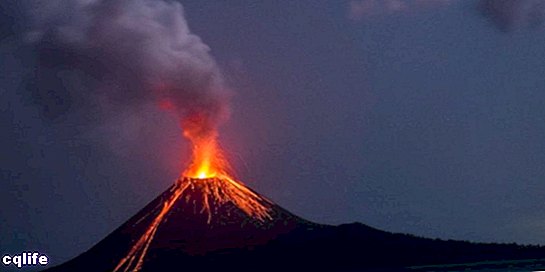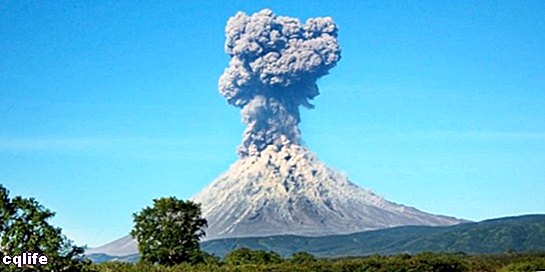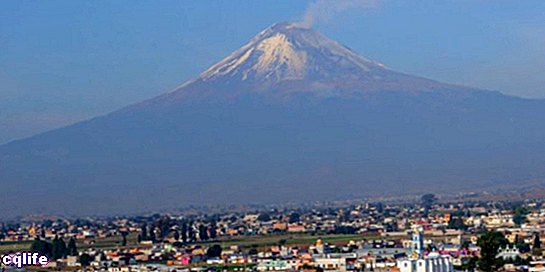- What its a volcanic eruption?
- Types of volcanic eruption
- Causes of volcanic eruptions
- Consequences of volcanic eruptions
- Safety measures in case of volcanic eruption
- Volcanoes of Mexico
We explain what a volcanic eruption is, the types of eruption, its causes and consequences. Also, security measures.

What its a volcanic eruption?
The volcanic eruption is an emission of magma (mass of molten rocks, liquids Y gases) that is found in the depths of the Earth where the temperature it is extremely hot. There a strong Pressure that pushes magma to the surface, seeping through fissures in the I usually and of the volcanoes.
Depending on the composition of the magna, some volcanic eruptions can be explosive and the expelled sediments can reach 20 kilometers in height. An eruption of that magnitude is a phenomenon unusual and represents a risk environmental because its effect can alter the weather during years.
Types of volcanic eruption
Volcanic eruptions are differentiated by their type of explosiveness, which depends on factors such as temperature, composition, viscosity and elements dissolved in magma. Volcanic eruptions can be:
- Gushing eruptions. Those in which the magma rises through the surface of the volcano in the form of lava or viscous liquid, with a low concentration of gases.
- Explosive eruptions. Those in which the magma retains a large amount of gases, acquires greater pressure as it rises to the land surface and it comes out with great force, in the form of solid fragments called pyroclasts.
Furthermore, volcanic eruptions are further subdivided, according to the geology from which they emerge, and can be:
- Magmatic eruptions. They are produced when magma rises to the surface in the form of lava, ash, or pumice. Depending on the shape of the volcano, they are called Icelandic, Hawaiian, Vulcan, Plinean and Pelean eruptions.
- Phreatomagmatic eruptions. They occur when magma interacts directly with a large mass of Water (as in the ocean, the sea or groundwater) so the magnitude of the underwater explosion cannot always be seen from the earth's surface. Depending on the shape of the volcano, they are called a Surtseyan, submarine or subglacial eruption.
- Phreatic eruptions. They are produced when magma (which is at an extreme temperature heat between 600º and 1100º C) makes contact with a volume of water that heats up abruptly, generating steam at very high pressure. A great explosion made up of steam, water, ash and sediments, but unlike other types of eruptions, magma does not usually rise to the earth's surface.
Causes of volcanic eruptions

A volcanic eruption (when magma tries to rise to the earth's surface) occurs because the tectonic plates they move (either by pulling apart or pushing against each other, causing them to overlap) and magma from below begins to rise between the gaps left by the plates.
As the magma rises, bubbles of gas form inside it that try to flow to the surface. When the magmatic consistency is thicker, these bubbles cannot flow easily and accumulate increasing pressure, until the explosion occurs.
Another form of volcanic eruption occurs when a body of groundwater comes into contact with extremely hot magma. The temperature of the water rises suddenly and there is an explosion of steam along with traces of sediment, but the magma does not finish rising to the surface.
Consequences of volcanic eruptions
Among the main consequences of volcanic eruptions are:
- The transfer of the populations. Many communities Entire people are forced to abandon their lands to escape the lava that is capable of destroying everything in its path (in some cases, it has buried entire villages). Once the explosion ceased, the environment in the surroundings it is tainted with ash clouds that hinder visibility and breathing.
- The temporary shortage of food and water. The hot materials emanating from the volcano mix with the water currents and form a mud that continues to move on the earth's surface. Fertile soils are ruined and safe water becomes unfit for consumption over a long period of time. weather.
- The alteration of the world climate. In the case of explosive volcanic eruptions, the diameter of the ash impact affects the earth's surface and the atmosphere causing lasting changes in the climate, even globally. Depending on the composition of the magma, the resulting ash can affect temperatures by making it hotter or colder than usual.
Safety measures in case of volcanic eruption
The most important thing if you live in an area near a volcano is to go to the local authorities to facilitate all the information necessary.
However, there are some general measures of security to keep in mind in the event of witnessing a volcanic eruption. For example:
- Stay away from areas where there are volcanoes that were detected as active.
- If you live near an area with an active volcano, know an evacuation route and have a vehicle that always has a reserve of fuel.
- Know the emergency plan established by the local authorities to know which are the evacuation routes and agreed meeting points.
- Have an emergency kit that contains: safety glasses or a mask, a flashlight, clothing that protects the extremities and a radio with batteries charged.
- If for some reason the area cannot be evacuated, close the doors and windows well, and block any other openings that communicate with the outside (such as the chimney) to prevent ashes from entering.
- Volcanic ash is pulverized rock, extremely harmful. It makes breathing difficult and can also damage engines and machinery, so it is important to avoid driving through an ash cloud. If the car is left in the middle of the road, it is essential to move it to the side to avoid accidents.
- Ash can make roads slippery, so avoid winding routes between valleys. It is important to drive at a reduced speed so as not to lose control in the event of unforeseen events.
- Avoid areas of depressions in the ground where the most harmful gases tend to accumulate and can remain even for a long time after a volcanic eruption.
Volcanoes of Mexico

In Mexico there are about 2,000 volcanoes identified as inactive, so they do not represent any danger. However, there are also 12 active volcanoes distributed in the south-central part of the country, such as the Colima and Popocatépetl volcanoes, which are monitored 24 hours a day.
It is estimated that 75% of the population of Mexico lives in areas near a volcano. The damage that a volcanic eruption can cause depends on the type of explosion. For example, if it is an eruption of fiery lava, the damage will be greater than if it is an eruption of fumes and ash.
